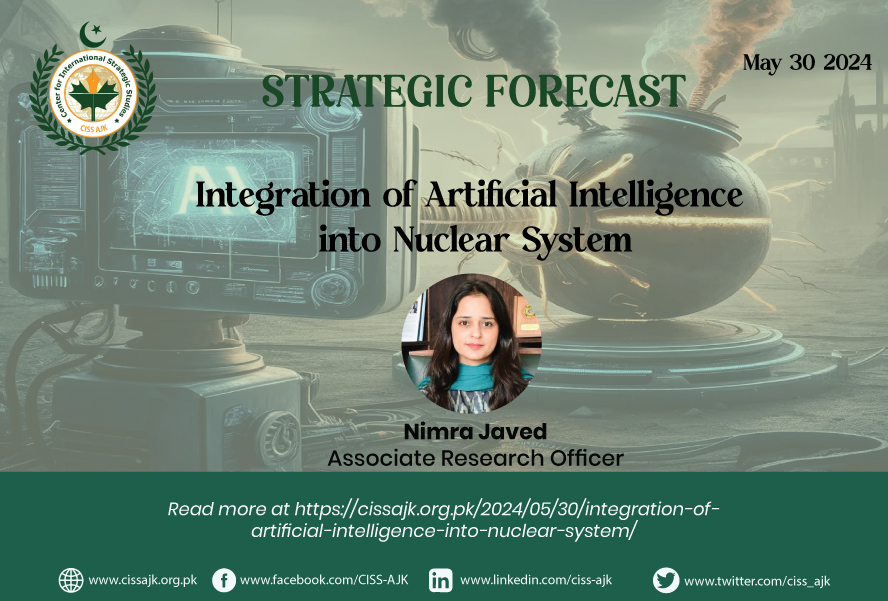This year marked the 26th anniversary of the Pakistan’s Youm-e-Takbeer in commemoration of Chagai-I and Chagai-II series of nuclear tests. The modernization of nuclear weapons is an ongoing process and world is also grappling the associated risks of nuclear weapons. The rapid development in technology has reshaped the landscape of nuclear security, presenting both challenges and opportunities in maintaining the deterrence, crisis stability, and progress towards disarmament. Although nuclear weapons have not been used in conflict for decades, the risk of their use persists. Around the world, countries are still building and modernizing nuclear arsenals. The swift progress in cyberspace and the emergence of technologies like artificial intelligence (AI) and hypersonic weapons increase the chances of near misses, accidents, and misinterpretations within the nuclear sphere.
Advancements in AI and cyber technologies present substantial dangers to the command-and-control networks overseeing the deployment of nuclear weapons. Attempts to disrupt these networks could mistakenly signal an imminent nuclear attack. Moreover, automating early warning systems and decision-making introduces risks, as machines lack the ability to make ethical judgments or question orders like humans do. Furthermore, no technology is infallible, and in the high-stakes nuclear domain, technological failures can be devastating.
The integration of AI into nuclear systems introduces a plethora of risks. AI systems necessitate vast amounts of data for learning and updating their conceptual frameworks of the world. For instance, Google’s AI brain simulator required 10 million images to self-teach recognition of cats. While data concerning scenarios involving nuclear weapons are comparatively scarce compared to the abundance of internet cat videos, the available empirical record on nuclear weapons incidents could potentially misinform AI algorithms. Instances of almost-launches and near-accidents during the Cold War, where both U.S. and Soviet early warning systems erroneously reported nuclear launches, underscore the potential pitfalls of utilizing historical data to train AI models within the nuclear domain. However, the consequences of AI errors in nuclear contexts far surpass those in other fields, accentuating the gravity of ensuring accuracy in AI applications.
Moreover, accidents in the nuclear arena carry amplified consequences. Past accidents involving automated conventional weapons systems, such as the inadvertent shooting down of British and U.S. fighter jets by U.S. Patriot missile batteries in 2003, underscore the potential dangers inherent in automated systems. As AI systems become increasingly complex and opaque to human comprehension, the likelihood of accidents is expected to rise, eroding trust in AI and automated systems and heightening apprehensions regarding the potential ramifications of AI integration into nuclear weapons systems.
Beyond accidents and immediate risks, the utilization of AI in nuclear weapons systems poses fundamental challenges to the principles of nuclear deterrence. The data collection and analysis capabilities of AI systems could enable precision strikes aimed at neutralizing critical command, control, and communication assets of nuclear forces—a departure from Cold War nuclear strategies that generally eschewed such counterforce targeting. This shift introduces the risk of undermining second-strike capabilities and thereby jeopardizing the concept of mutually assured destruction. For instance, AI systems could potentially identify nuclear submarines or disrupt nuclear command and control systems, thus compromising crucial components of the nuclear triad. This dynamic could exert pressure on leaders to employ their nuclear arsenals pre-emptively, rather than risk potential loss or compromise in the future.
Even if states were to agree to refrain from utilizing AI for counterforce purposes, the mere prospect of such employment remains destabilizing. Accordingly, states require a credible means of signalling their intentions regarding the utilization of AI within their nuclear systems, including delineating permissible and impermissible applications of AI technology.
The implications of AI development encompass both opportunities and risks, with the decisive factor lying in the manner of its utilization rather than the technology itself. As highlighted by the Stockholm International Peace Research Institute, during crises or conflicts, factors such as geopolitical tensions, communication deficiencies, and insufficient signaling of intentions may hold greater significance than the mere presence of AI technology. Therefore, efforts aimed at managing and comprehending the risks and advantages associated with AI should encompass confidence-building measures (CBMs) and inclusive stakeholder dialogue.
CBMs play a pivotal role in mitigating mistrust and misunderstanding, facilitating actors to demonstrate both their determination and restraint. Analogous to conventional weaponry, transparency regarding the intended use of AI systems by states serves as one form of CBM, while establishing channels of communication, particularly crucial in crisis scenarios, represents another avenue worthy of exploration.
Sustained engagement in dialogue with diverse stakeholders, encompassing governmental bodies, corporations, and civil society, holds paramount importance in cultivating and disseminating norms pertaining to AI utilization. Past experiences with workshops and discussions concerning the militarization of AI and its implications for international security underscore the potential productivity and feasibility of such dialogues.
In conclusion, the integration of AI within nuclear systems presents profound implications for Pakistan’s nuclear security paradigm. Against the backdrop of commemorating the anniversaries of its nuclear tests, Pakistan confronts the exigencies stemming from rapid technological progress. The incorporation of AI into nuclear command-and-control frameworks raises the specter of inadvertent nuclear escalation, given the potential for operational disruptions and misinterpretations.
Moreover, the delegation of decision-making authority to AI algorithms within early warning systems introduces ethical quandaries and vulnerabilities to technological malfunctions. Moreover, the deployment of AI technologies introduces the risk of precision targeting, imperiling critical nuclear assets and potentially eroding Pakistan’s nuclear deterrence capability.
To navigate these challenges effectively, Pakistan must prioritize transparency, engage in confidence-building measures, and foster inclusive dialogues among stakeholders to ensure the judicious and responsible integration of AI technologies within its nuclear arsenal.

